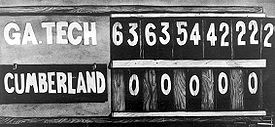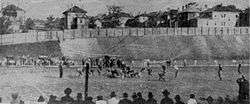1916 Cumberland vs. Georgia Tech football game
The 1916 Cumberland vs. Georgia Tech football game was the most lopsided in the history of college football, with Georgia Tech winning 222–0.[1][2][3] The game was played on October 7, 1916, between the Georgia Tech Engineers and Cumberland College Bulldogs at Grant Field (now a part of Bobby Dodd Stadium) in Atlanta.
| Most lopsided game in college football history | |||||||||||||||||||
|---|---|---|---|---|---|---|---|---|---|---|---|---|---|---|---|---|---|---|---|
 | |||||||||||||||||||
| |||||||||||||||||||
| |||||||||||||||||||
| Date | October 7, 1916 | ||||||||||||||||||
| Season | 1916 | ||||||||||||||||||
| Stadium | Grant Field | ||||||||||||||||||
| Location | Atlanta | ||||||||||||||||||
With Cumberland opting to punt on multiple possessions, the infamous score can be partially attributed to 97% of the game's plays occurring in Cumberland territory, with 64 of those plays occurring in Cumberland's own red zone.
Background
Cumberland College, a Presbyterian school in Lebanon, Tennessee, had discontinued its football program before the season but was not allowed to cancel its game against the Engineers.[1][2] The fact that Cumberland's baseball team had crushed Georgia Tech earlier that year 22–0 (amidst allegations that Cumberland used professionals as ringers) probably accounted for Georgia Tech coach John Heisman's running up the score on the Bulldogs, as Heisman was also Georgia Tech's baseball coach.[1][2] It is speculated that Heisman may have deliberately aimed for a score of exactly 222 as a numerically significant retaliation to Cumberland's 22.[4] He insisted on the schools' scheduling agreement, which required Cumberland to pay $3,000 (equivalent to $70,000 in 2019) to Tech if its football team failed to show.[1][2] In fact, Heisman actually paid Cumberland $500 (equivalent to $11,700 in 2019) as an incentive to play the game; his letter to Cumberland's athletic department read in part:
I hereby offer you the sum of $500 and an all-expenses-paid trip to Atlanta for your football team on the condition that you honor your contract by participating in and completing the Cumberland-Georgia Tech football game ... However, if this offer is refused ... I shall be forced to demand that your school reimburse the Tech Athletic Dept. in the amount of $3,000 for losses from the projected net gate receipts ...[5]
George E. Allen (who was elected to serve as Cumberland's football team student manager after first serving as the baseball team student manager) therefore put together a team of 12–16 players,[lower-alpha 1] most of whom were his fraternity brothers, to travel to Atlanta as Cumberland's football team.[2]
Another reason for Heisman's plan to run up the score was the practice among the sportswriters of the time to rank teams based upon how many points they scored. Since this statistic did not account for the strength or weakness of a team's opponent, Heisman disagreed with the amount of weight the writers tended to assign to it, and he may have unleashed his players on Cumberland to make his point.[6]
The game
Cumberland received the opening kickoff and failed to make a first down. After a punt, the Engineers scored on their first play.[1][3] Cumberland then fumbled on their next play from the line of scrimmage, and a Georgia Tech player returned the fumble for a touchdown.[1][3] The Bulldogs fumbled again on their next play, and it took Georgia Tech two rushes to score its third touchdown.[1][3] Cumberland lost nine yards on its next possession, and Georgia Tech scored a fourth touchdown on another two-play drive.[2][3]
Georgia Tech led 63–0 after the first quarter and 126–0 at halftime. Georgia Tech added 54 more points in the third quarter and 42 in the final period.[2][3] Several players on the heavily-outmatched Cumberland side suffered serious injuries during the game, including quarterback Edwards, who was thrice carted off with concussions.
Georgia Tech scored a total of 32 touchdowns, and Georgia Tech's left end James Preas kicked 18 extra points.[7] Cumberland's only effective defense was an extra point blocked with a sort of human pyramid topped with Vichy Woods, who suffered a gruesome facial injury on the play.[2] Despite scoring 32 touchdowns, the Engineers did not complete or attempt a forward pass: all their yardage came on rushes, returns or defensive plays.
Several myths have developed around the game. Some have written that Cumberland did not have a single play that gained yards; in fact, its longest play was a 10-yard pass (on 4th-and-22[1][2] or 3rd-and-18[3]). One page on Cumberland's website says Georgia Tech scored on every offensive play, but the play-by-play account of the game refutes this and suggests a more likely scenario: that Georgia Tech scored on every one of its sets of downs. Thus, neither team made a first down that was not also a touchdown, as Cumberland made no first downs in the entire game.[3]
Cumberland purportedly committed 15 turnovers—nine fumbles and six interceptions—during the game.
As a general rule, the only thing necessary for a touchdown was to give a Tech back the ball and holler, ‘Here he comes’ and ‘There he goes.’
— The Atlanta Journal, 1916
Sportswriter Grantland Rice wrote, "Cumberland's greatest individual play of the game occurred when fullback Allen circled right end for a 6-yard loss."[5][8] At halftime, Heisman reportedly told his players, "You're doing all right, team, we're ahead. But you just can't tell what those Cumberland players have up their sleeves. They may spring a surprise. Be alert, men! Hit 'em clean, but hit 'em hard!"[8][9] However, even Heisman relented, and shortened the third and fourth quarters from 15 minutes to 12.[9]
Statistics

- These statistics are based on the play-by-play transcript and may be incomplete.
| Team | Rushing | Passing | Kicking | |||||||||
|---|---|---|---|---|---|---|---|---|---|---|---|---|
| Att | Yards | TD | Fumb Lost | Comp–Att | Yards | TD | Int | FGM–FGA | XPM–XPA | |||
| Cumberland | 27 | −42 | 0 | 9 | 2–18 | 14 | 0 | 6 | 0–0 | 0–0 | ||
| Georgia Tech | 26 | 522 | 18 | 0 | 0–0 | 0 | 0 | 0 | 0–0 | 30–32 | ||
| 1 | 2 | 3 | 4 | Total | |
|---|---|---|---|---|---|
| Cumberland | 0 | 0 | 0 | 0 | 0 |
| Georgia Tech | 63 | 63 | 54 | 42 | 222 |
at Grant Field, Atlanta
- Date: October 7, 1916
- Game time: Day game
- Play-by-Play
| Game information | ||
|---|---|---|
|
Records
Since World War II, only a handful of schools have topped 100 points in a college football game. The modern-era record for most points scored against a college opponent is 106 by Fort Valley State of Georgia against Knoxville College in 1969. In the previous year Houston defeated Tulsa 100–6 to set the NCAA record in major college football. In 1949 the University of Wyoming defeated University of Northern Colorado 103–0. The Division III football scoring record was set in 1968 when North Park University defeated North Central College 104–32, using ten passing touchdowns along the way.[10]
Legacy
The game ball had the score written on it as a memento. It was donated to the Helms Athletic Foundation sports museum by Bill Schroeder, an avid sports collector. When the museum moved locations in the 1980s, the ball was boxed and remained in storage. In 2014, Ryan Schneider, a Georgia Tech alumnus, purchased the ball in a charity auction for $40,388 ($33,657 without buyer's premium), with the intention of donating it back to Georgia Tech.[11]
In October 1956, a 40th reunion was held for players from both teams, of whom 28 were able to attend.[9] While reminiscing, one of the Cumberland players pointed out one play that saved Cumberland from an even worse defeat; had Cumberland punted as normal instead of running a sneak, the score would probably have been 229–0.[9]
Notes
- Conflicting sources report anywhere from 12 to 19 players (and of those 19, 3 got lost in Nashville and missed their train, leaving at most only 16 players).[5]
- "George Murphy" may have actually been a ringer named John "Johnny Dog" Nelson, a sportswriter who had previous football experience.
References
- Litsky, Frank (October 7, 2006). "In 1916, a Blowout for the Ages". The New York Times. Retrieved May 18, 2015.
- Paul, Jim (1983). You Dropped It, You Pick It Up. Baton Rouge, Louisiana: Ed's Publishing Company. ISBN 99934-0-444-6.
- Davis, Parke H. (October 15, 1916). "Yellow Jackets-Cumberland Score Was Record One; Tops the List According to Statistics Compiled Showing All Scores Past the Century Mark". The Atlanta Constitution. pp. A3.
- "Revisiting Georgia Tech 222, Cumberland 0 and how it may have saved the school". October 7, 2016. Retrieved March 2, 2017.
- "A Loss That Lives In Legend Cumberland Crashed In Football, 222-0". August 26, 1990. Retrieved May 18, 2015.
- Nash, Bruce (1990). Football Hall of Shame. Schuster Merchandise. ISBN 978-0-671-72922-6.
- "Makes a Record Score". The Washington Post. October 8, 1916. p. S3.
- "220-0-the Infamous Cumberland Gap". September 16, 1990. Retrieved May 18, 2015.
- "A Monumental Victory". October 6, 2006. Retrieved May 18, 2015.
- North Central College Football Record Book ("Archived copy" (PDF). Archived from the original (PDF) on 7 March 2012. Retrieved 5 October 2017.CS1 maint: archived copy as title (link)).
- Sugiura, Ken (August 25, 2014). "Tech alum returning 222-0 ball to 'rightful place'". The Atlanta Journal-Constitution. Retrieved May 18, 2015.
External links
- The Game of the Century at Cumberland University (via archive.org).
- GEORGIA TECH 222, CUMBERLAND 0. – 100th anniversary tribute by SB Nation